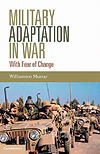
Military Adaptation in War: With Fear of Change, by Williamson Murray, Cambridge University Press, England, 2011, $35
Between the Persian Gulf War and the Iraq War we heard a great deal of pontificating about “the changing nature of war.” Politicians, pundits and self-appointed defense experts from both sides of the political spectrum lined up to predict an immediate future in which modern nations would conduct wars efficiently and antiseptically through such mechanisms as “information dominance,” “network-centric warfare” and, of course, “shock and awe.” Apparently airpower and PowerPoint were going to make the messy “boots on the ground” form of warfare obsolete. It hasn’t quite worked out that way.
As Professor Williamson Murray makes clear in his important new book, Military Adaptation in War: With Fear of Change, the nature of war is not changing. It always has been, as German military theorist Carl von Clausewitz described it, an act of force to compel an enemy to do something against his will. It is a brutal, nasty, bloody business, in which the two fundamental actions consist of killing or avoiding being killed. What does change, however, are the methods (tactics) and tools (weapons) of war. Advances in the direct and indirect technologies of warfare also tend to increase the speed of military operations and the potential scope of their destruction. Every weapon and every military system introduced eventually spawns a countersystem. Change, then, is a constant in warfare; and as technology advances, the tempo of that change increases. The side that manages to stay at least one step ahead of the enemy usually has the advantage. But not all change introduced by armies works or turns out to be change for the better. Therein lies the rub.
In 1996 Murray and Professor Allan R. Millett produced a book that examined the problems of military innovation. In this new volume Murray takes up the matter of military adaptation. Innovation and adaptation, although similar in some respects, are quite different problems. Innovation is a methodical and deliberate process of change during peacetime. Military organizations attempt to draw and apply the lessons of the past and incorporate those lessons into new tactical and operational doctrines based on the latest technologies. But the problem with the innovation process is that it can only be carried out within the framework of a most likely future enemy. In the end no army ever gets its next war exactly right, but the objective is to get it as close as possible.
Unlike innovation, adaptation is a wartime process in which a military force comes to grips with its actual tactical, operational and strategic environments, even as it seeks to understand what the enemy is trying to do, how he is trying to do it and how best to defeat him. Adaptation is a process conducted under the pressure of war. The objective is to defeat an enemy, who in turn can be counted on to do the same thing to you. The margin for error is always slim, and as the saying goes, “The enemy always gets a vote.”
Most of this book focuses on historical lessons from successful or flawed adaptations during the 20th century, from World War I to the Yom Kippur War. The period from 1914–18, in particular, represents the most radical and rapid change in war-fighting tactics and technologies in recorded history. Perhaps the most fascinating part of the book is in the two chapters Murray devotes to the air war between the Royal Air Force and the Luftwaffe. Murray’s analysis of the leadership of Air Chief Marshal Sir Hugh Dowding during the Battle of Britain is alone worth the price of the book.
—David T. Zabecki




